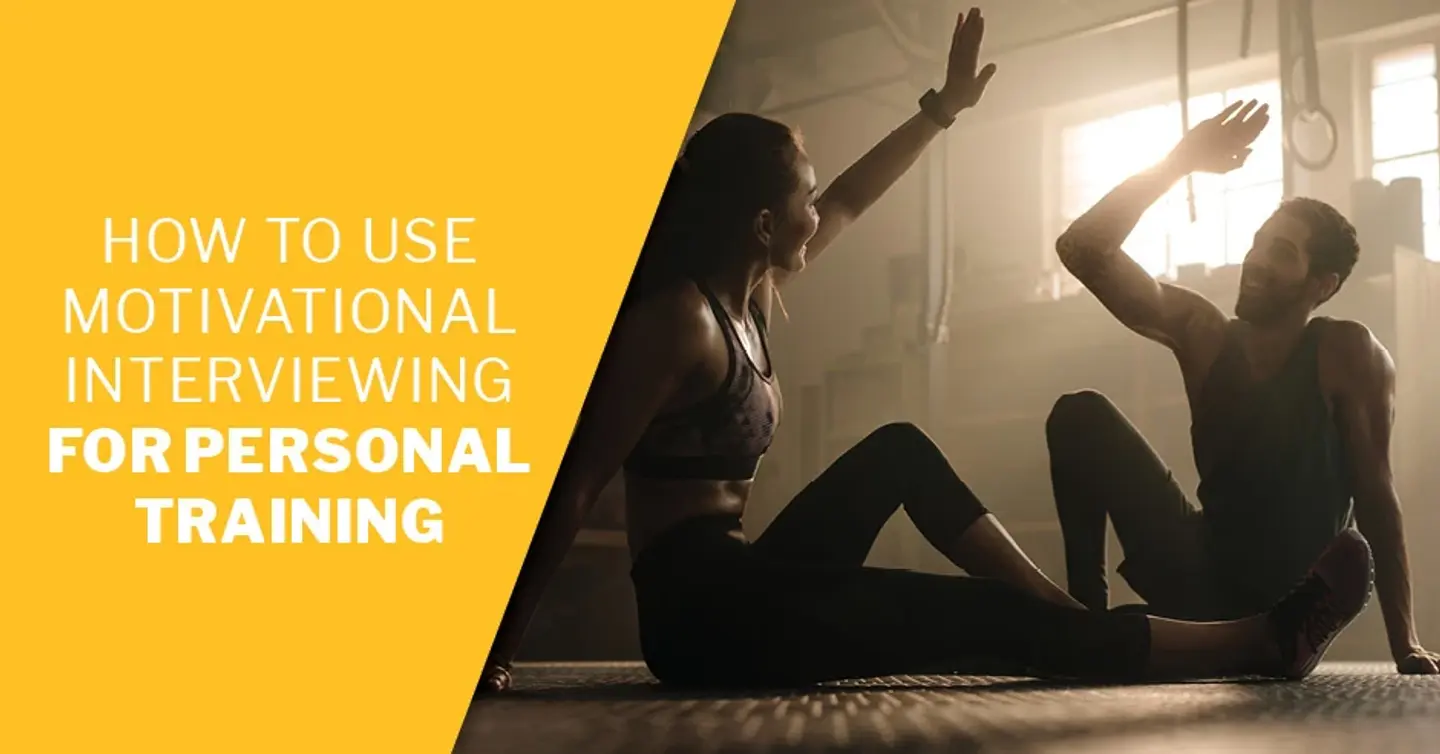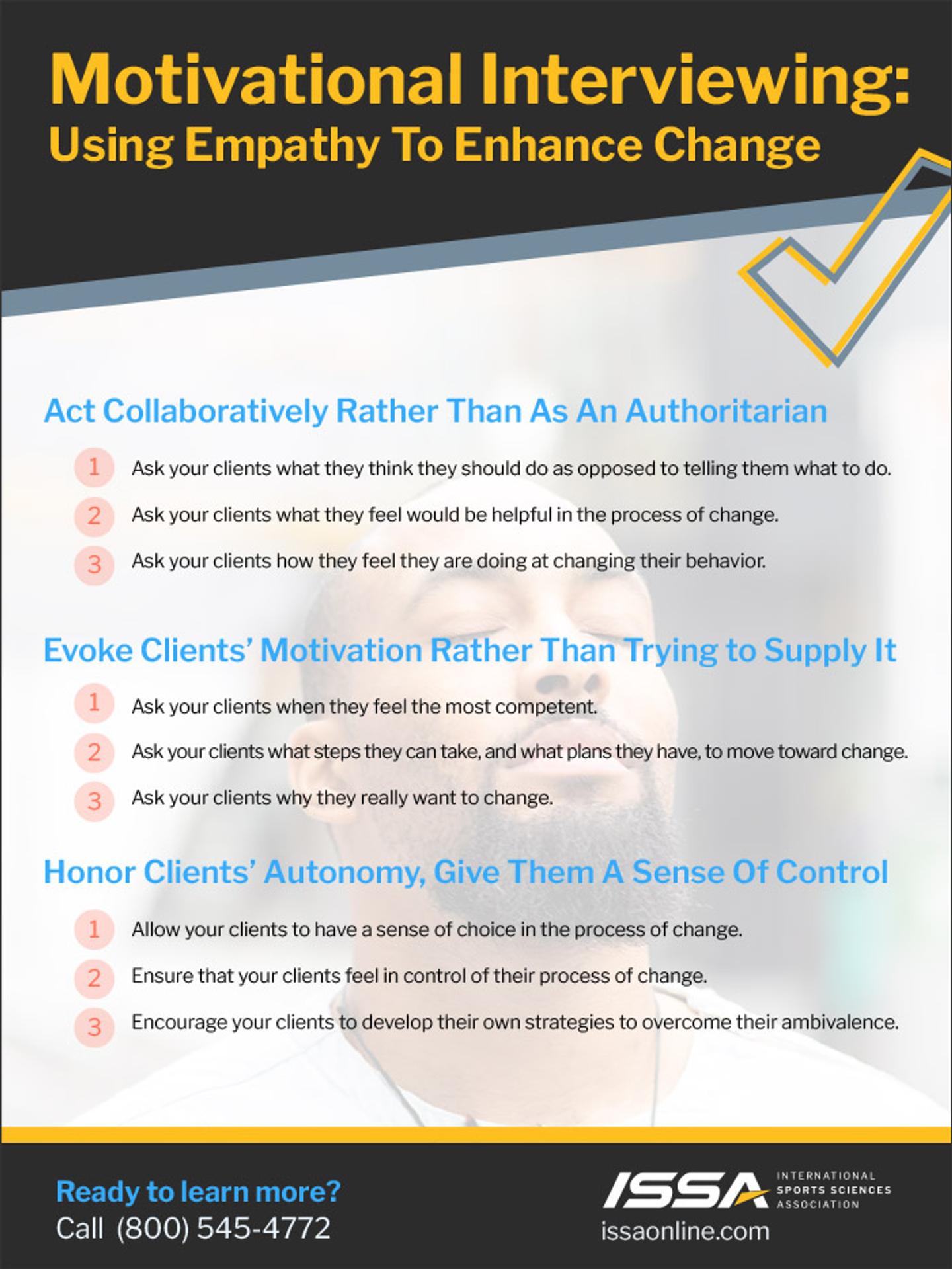
How to Use Motivational Interviewing for Personal Training
Reading Time: 5 minutes 55 seconds
BY: ISSA
DATE: 2023-12-06
You can be the best personal trainer in the world, yet still have clients who don't sustain long-term results. Their unhealthy behavior comes creeping back, making you feel like you've let them down. You may even start to question your coaching methods and whether they work.
Your first reaction when this happens might be to go back to the drawing board and create a whole new training approach. Don't do that just yet.
The issue may have nothing at all to do with your methods or style. Instead, you may find that you can help clients get better results by adding one more step in your exercise program. That step involves motivational interviewing.
What Is Motivational Interviewing?
You can't maintain a positive health behavior without motivation. Motivational interviewing is a method used to stoke a client's internal or intrinsic motivation. Originally, it was created to help people struggling with substance abuse. Now this technique is used in the fitness industry. It can help promote lasting weight loss, increase regular physical activity, and make it easier to stick to a personal training program.
Motivational interviewing assumes that all people can reach their full potential. This behavioral change model also recognizes that ambivalence—having contradicting beliefs and behaviors—is a normal part of the process. Further, it is the role of the coach to help identify a client's ambivalence. This is followed by finding ways to begin to match their beliefs with positive change.
Benefits of Motivational Interviewing for Personal Training Clients
One advantage of motivational interviewing is that it increases the odds of creating a lasting behavior change. But research reveals that this method offers other benefits as well.
A 12-month study found that motivational interviewing is beneficial for people with a high risk of cardiovascular disease. It helped by offering greater improvement in their body mass index (BMI) and cholesterol levels. That makes it beneficial to a nutrition and fitness program.
Other pieces of research have found that motivational interviewing improves results for people of all ages. One such study involved 185 obese kids. It found that this method was useful for "improving behaviour changes in eating, physical activity and weight loss."
5 Principles of Motivational Interviewing
If you'd like to incorporate this type of interviewing into your training program, it's helpful to understand its basic philosophies. Motivational interviewing operates under five principles:
Expressing empathy is necessary. It helps you develop an open and trusting coach-client relationship.
You must uncover existing ambivalence. It is the goal of the motivational interviewer to find where beliefs and actions differ.
Arguing and confronting have no place in motivational interviewing. This only shuts the client down and hinders the change process.
You will get further ahead by adjusting to client resistance. If you try to fight your client's resistance, it can harm your relationship. This stops their progress.
The best way to support your clients is with optimism and encouragement. Be supportive and positive. Help them develop an "I've got this" attitude.
Finding ways to master these principles enables you to help your clients more effectively. It also provides better coaching results. The better their results, the more appealing you are as a personal trainer. Check out the ISSA's Transformation Specialist course to take your coaching and behavior change skills to the next level!
How to Use Reflective Listening to Show Empathy
Since the first principle of motivational interviewing involves showing empathy, it is important to learn this skill. Being empathetic requires that you understand your client's feelings. This is where reflective listening comes into play.
Reflective listening is about seeking to understand the meaning of your client's words. It does not assume that you know how they feel. Rather, it attempts to clarify that you have a complete understanding of what it is they're saying.
A good reflective listening approach is to repeat what your client has said in your own words. This allows them to correct any misunderstandings. Use a statement such as, "So, what I hear you saying is..." If you sense a specific emotion coming from them, mention that too.
It is also helpful to ask open-ended questions when interviewing clients. This gives them the opportunity to fully explain how they feel. "Tell me more about your smart goals" is an example. "How has not reaching your goals affected your mental health?" is another.
Motivational Interviewing Techniques for Uncovering Ambivalence
A prime example of ambivalence is a client who wants to lose weight but still snacks on candy every night. Their behavior doesn't match their goals. Getting these two things aligned is critical to helping them obtain (and sustain) lasting results.
Uncovering a client's ambivalence requires that you pay particular attention to the ways their fitness goals and behaviors are misaligned. Next, use your reflective listening skills to point out any discrepancies. Help your client realize that they are saying one thing but doing another.
The goal is to point out their ambivalence in a way that is not accusatory or confrontational. Instead, help them understand that we all have ambivalence on some level. More importantly, recognizing ambivalence is necessary for achieving behavior change. That makes it a good thing!
Effective Ways to Handle Client Resistance as a Personal Trainer
As a personal trainer, you've likely experienced client resistance. In some cases, resistance appears by overtly defying your suggestions. Other times, resistance is a bit more passive. The client simply "goes through the motions" without giving it their all.
What's the best way to handle client resistance? Here are a few options to consider:
Addressing their resistance without emotion. Instead of getting angry, simply acknowledge their resistance using a neutral tone. Sometimes just hearing it said back to them is enough to instigate a positive response.
Point out discrepancies between things they've said. Maybe in the first training session, the client said they'd be willing to exercise four days a week. Now they say that they only have two days per week to commit. Ask them about this discrepancy to uncover the reasons behind the change.
Focus more on opportunities than obstacles. If your client is focused on the obstacles they face, you're going to have a tough time changing their behavior. Yet, if you can get them to see these hurdles as opportunities to grow, it alters their view of the process. They may even look forward to overcoming their fitness challenges. Exercise becomes more fun because they're making progress.
Agree with them, kind of. Another way to address client resistance is to agree with certain parts of what they say. At the same time, strive to get them to see the big picture. This helps them begin to think about how they can move forward with their fitness and nutrition.
Tips for Enhancing Your Clients' Personal Motivation
The ultimate goal of motivational interviewing is to increase your client's inner desire to reach their fitness goals. It is to raise their motivation as high as it can go. How do you do this?
The three main elements of motivation are autonomy, mastery, and purpose. Autonomy means that they are making these changes because they want to, not as a way to satisfy someone else. Mastery involves feeling as if they fully understand how to hit their goals, and purpose is having a deep, compelling reason for wanting to change.
If you can incorporate all three of these elements in your fitness program, you will help your clients achieve lasting results. The first step is to educate your client as to how important each of these is to motivation. Then assess their level of autonomy, mastery, and purpose so you know where they are beginning.
Next, identify any barriers they may have regarding these three elements. Ask if there is someone else pushing them to eat better or exercise. Inquire about any fears or insecurities they have when it comes to changing their behavior.
Finally, implement steps to reinforce their autonomy, mastery, and purpose. Find ways to help them establish more control over their nutrition and fitness. Help them build mastery in regard to diet and exercise. This could involve referring them to a nutrition therapist or someone trained in dietetics.
Also work with them to find their larger purpose. How would making positive lifestyle changes help them better connect with others? How would it contribute to a more positive life?
Motivational interview training can better prepare you to help clients achieve long-term behavior change. This training is available in the ISSA's Transformation Specialist certification course. This program teaches the science behind this technique, providing many ways to boost your motivational interviewing skills.

Download this FREE infographic here!
Featured Course
ISSA | Transformation Specialist
As a Transformation Specialist you will be armed with the skills and techniques required to truly coach and influence behavioral patterns as they relate to your clients physical, mental and emotional well-being. With this skill, your clients will see better results quicker and have an easier time with the transition to the behaviors and activities you suggest.